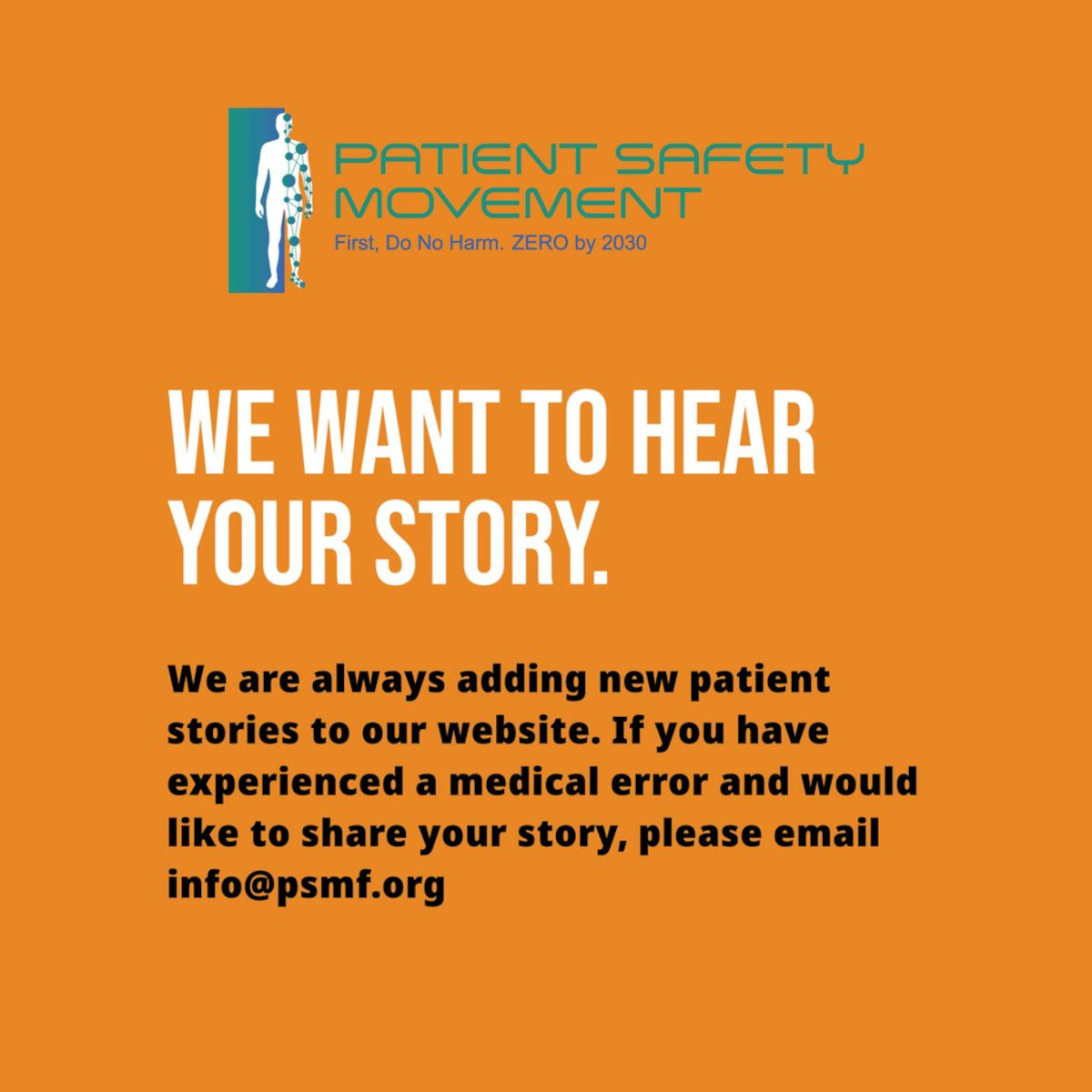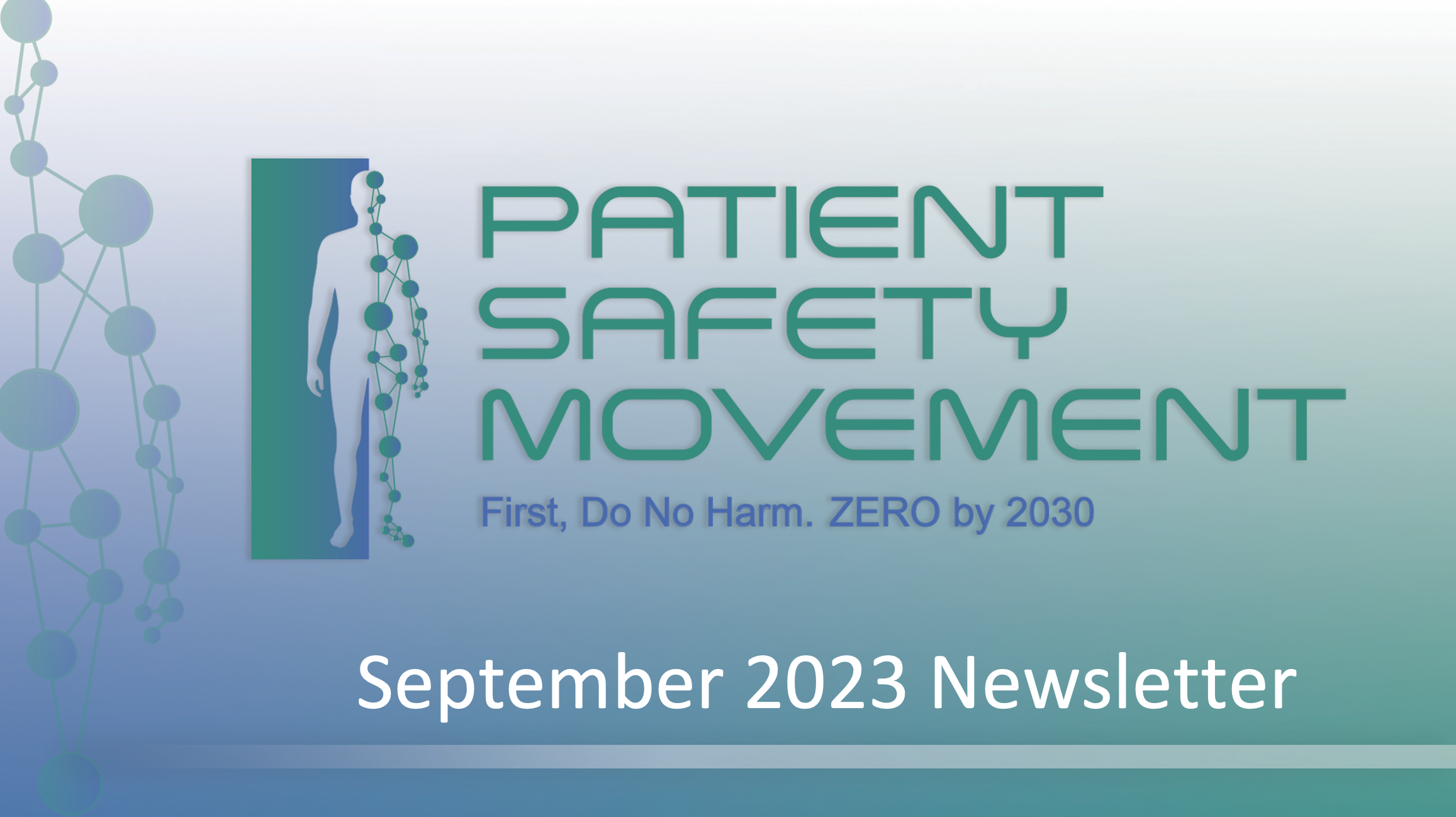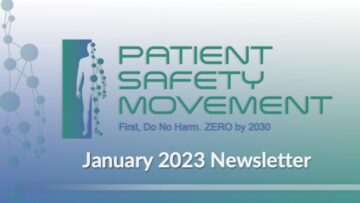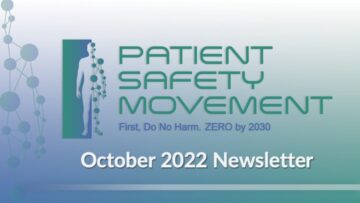Clinton Global Initiative Panel
Our Founder Joe Kiani recently participated in a panel on Health Equity at the Clinton Global Initiative 2023 Meeting, moderated by Chelsea Clinton. During the fireside chat format discussion, Joe touched on why patient safety is such an important issue, the goal of global access to healthcare that is safe and dignified, and how the Patient Safety Movement Foundation has worked to unify a broad range of healthcare stakeholders and patients, our process of developing solutions to common safety issues, securing commitments to share data, and bringing love to the equation.
Beta Healthcare Symposium
Joe Kiani also recently gave a keynote at Beta Healthcare Group’s 2023 Annual Member Symposium focused on “Strategies for Improving Patient & Employee Safety,” held in Dana Point, California. During his speech, Joe provided an overview of the PCAST report recommendations, the current state of patient safety efforts and strategies for reaching ZERO, and issues around opioid safety. Beta Healthcare is the largest professional liability insurer of hospitals on the West Coast, providing coverage to more than 600 hospitals and healthcare facilities.
World Patient Safety Day – September 17

The theme of World Patient Safety Day 2023 on September 17 was “Engaging Patients for Patient Safety” to recognize the crucial role patients, families, and caregivers play in the safety of healthcare. Evidence shows that when patients are treated as partners in their care, significant gains are made in safety, patient satisfaction, and health outcomes. Through this year’s slogan “Elevate the voice of patients!” WHO calls on all stakeholders to take necessary action to ensure patients are involved in policy formulation, represented in governance structures, engaged in co-designing safety strategies, and active partners in their own care. WHO established World Patient Safety Day in 2019 to increase public awareness and engagement, enhance global understanding, and work toward global solidarity and action to enhance patient safety and reduce patient harm.
PCAST: A Transformational Effort on Patient Safety
Earlier this month, the President’s Council of Advisors on Science and Technology (PCAST) released its findings and recommendations on patient safety to US President Joe Biden. Titled “A Transformational Effort on Patient Safety,” the report draws critical attention to the urgency of patient safety as a national public health issue. The distinguished PCAST Working Group on Patient Safety was co-led by PSMF Founder Joe Kiani and Microsoft’s Chief Scientific Officer, Eric Horvitz.
The report cites recent data indicating approximately one in four Medicare patients experience adverse events during their hospitalizations, with many resulting in catastrophic outcomes, including death. More than 40 percent of these events are due to preventable errors. Moreover, the report confirms that “adverse outcomes of unsafe care disproportionately impact people experiencing social marginalization due to race, ethnicity, sexual orientation, gender identity, income, education, socioeconomic status, or physical and mental ability, resulting in health disparities.”
The PCAST report also draws attention to the fact that medical errors and patient injuries persist at alarmingly high rates despite ongoing efforts to improve quality care on the part of practitioners and their organizations. Though many healthcare professionals do strive to implement evidence-based safety protocols to reduce preventable medical errors, nationwide implementation of many of these known solutions has lagged. The report goes on to urge that now is the right time to renew the nation’s commitment to improving patient safety, noting that changes will be far more likely with strong committed government leadership working to advance the recommendations outlined in the report.
Letter from CEO

September is the month for patient safety. In 2019, World Patient Safety Day on September 17 was established at the World Health Organization’s (WHO) World Health Assembly through the adoption of a resolution. Its objectives are to increase public awareness and engagement, enhance global understanding, and work toward global solidarity and action.
This year’s theme is “Engaging patients for patient safety,” and their slogan is “Elevate the voice of patients!” When WHO shines a global light on an issue as important as this, it helps all of us move the patient safety needle forward.
On September 12 and 13, our COO, Dr. Sanaz Massoumi, presented at WHO’s “World Patient Safety Day 2023 Global Conference” in Geneva. She was in incredible company—session presenters included Dr. Tedros Adhanom Ghebreyesus, Dr. Neelam Dhingra, The Rt Hon Jeremy Hunt, Sir Liam Donaldson, Dr. Ingo Härtel, Dr. Henrietta Hughes, Vonda Bates, Helen Haskell, Sue Sheridan, and Melissa Sheldrick.
Just a few days before on September 6, the Anesthesia Patient Safety Foundation (APSF) held its Stoelting Conference. The APSF president, Daniel Cole, MD, chose to focus this year on “Emerging Medical Technologies—A Patient Safety Perspective on Wearables, Big Data and Remote Care.” Dr. Susan McGrath, a biomedical engineer and director of the Surveillance Analytics Core at Dartmouth Hitchcock Medical Center, presented data collected over 15 years that showed continuous monitoring saved patient lives, reduced patient harm, and reduced costs. I also referenced her data in my article “Cost Savings Through Zero Preventable Deaths,” published this month on HealthManagement.org.
On September 11, the National Association for Healthcare Quality (NAHQ) had its virtual meeting where it reviewed quality and safety of healthcare. We contributed a video on patient safety and the recommendations from PCAST.
On September 14, I joined a virtual panel for Imperial College London’s World Patient Safety Day Event.
On September 17, we arranged for permits for patient safety advocates and us to walk from Freedom Plaza to the Capitol Building in Washington, DC, and plant orange flags in memory of patients harmed by healthcare.
On September 18, the Clinton Global Initiative 2023 meeting in New York included our Founder and Governance Board Member, Joe Kiani, on a panel discussing opioid overdose and measures that can be taken to reduce this.
On September 19, Dr. Sanaz Massoumi and I gave a presentation virtually to the Brazilian Society for Patient Safety, Safety4me.
On September 20, our Board Chair, Dr. Mike Durkin, and I traveled to San Luis Potosi to speak at a celebration for World Patient Safety Day in Mexico.
On September 21, our Founder, Joe Kiani, was one of the keynote speakers at the 2023 Beta Healthcare Annual Member Symposium.
On September 30, I attended a virtual meeting in India of the Association of Nurse Executives at their Annual Patient Safety Conference with the theme “Towards Zero Harm: Elevate the Voice of Patients.”
On September 7, we celebrated a huge milestone for patient safety when the President’s Council of Advisors on Science and Technology (PCAST) submitted their recommendations on transforming patient safety to President Joe Biden. PCAST formed, at President Biden’s request, a working group on patient safety. They were led by Joe Kiani, PSMF founder, and Eric Horvitz, chief scientific officer of Microsoft, and joined by Dr. Don Berwick, Lisa Cooper, Sue Desmond-Hellmann, Chris Hart, Harlan Krumholz, Julie Morath, Dr. Peter Pronovost, and Sue Sheridan. We are very hopeful that President Biden will put all these recommendations into force immediately. Everything that PSMF has been recommending on its website for years has been addressed, as shown below in the complete list of PCAST recommendations:
Recommendation 1: Establish and Maintain Federal Leadership for the Improvement of Patient Safety as a National Priority.
1.A Appoint a Patient Safety Coordinator, Reporting to the President, on Efforts to Transform Patient Safety Among All Relevant Government Agencies.
1.B Establish a Multidisciplinary National Patient Safety Team, Including Those Most Affected.
Recommendation 2: Ensure That Patients Receive Evidence-Based Practices for Preventing Harm and Addressing Risks.
2.A Identify and Address High-Priority Harms and Promote Patient Safety Through Incentivizing Adoption of Evidence-Based Solutions and Requiring Annual Public Reporting Immediately with an Aspiration of More Frequent Reporting in the Future.
2.B Create a Learning Ecosystem and Shared Accountability System to Ensure That Evidence-Based Practices are Implemented and Goals for Reduced Harms and Risks of Harm for Every American are Realized.
2.C Advance Interoperability of Healthcare Data and Assure Free Access to the Tracking of Harms and Use of Evidence-Based Solutions.
Recommendation 3: Partner with Patients and Reduce Disparities in Medical Errors and Adverse Outcomes.
3.A Implement a “Whole of Society Approach” in the Transformational Effort on Patient Safety.
3.B Improve Data and Transparency to Reduce Disparities.
Recommendation 4: Accelerate Research and Deployment of Practices, Technologies, and Exemplar Systems of Safe Care.
4.A Develop a National Patient Safety Research Agenda.
4.B Harness Revolutionary Advances in Information Technologies.
4.C Develop Federal Healthcare Delivery Systems’ Capacities and Showcase Results as Exemplars of Safer Healthcare.
If we keep this incredible momentum going and if patient safety organizations continue to work closely together, I am optimistic that we can eliminate preventable patient and healthcare worker harm in the US and around the world.
In Health,

Michael A.E. Ramsay, MD, FRCA, Chief Executive Officer, PSMF
World Sepsis Day – September 12, 2023
A Statement from Dr. Konrad Reinhart
Sepsis is a severe and potentially life-threatening medical condition that occurs when the body’s response to infection becomes dysregulated, leading to widespread inflammation throughout the body. Sepsis begins outside of the hospital for nearly 80% of patients. It can result from various types of infections, such as bacterial, viral, or fungal infections. The most common infections that can lead to sepsis include pneumonia, urinary tract infections (UTIs), abdominal infections, as well as skin and soft tissue infections.
Sepsis is one of the most common preventable diseases and causes of death worldwide. In 2017, the World Health Organization (WHO) called in a sepsis resolution for all member states to initiate national measures that can lead to the prevention of sepsis, improvement of its early detection and diagnosis, and better treatment of sepsis patients. According to WHO, the majority of sepsis cases are preventable through early detection, treating sepsis as an emergency, and strategies aimed at reducing the risk of infections progressing to sepsis (vaccinations, hygiene measures, prompt treatment).
Between 47 and 50 million individuals are impacted annually, with a staggering 11 million lives lost, equivalent to a tragic fatality occurring approximately every 2.8 seconds. The mortality rate varies significantly by country, ranging from 15% to over 50%. Not only is a sepsis diagnosis associated with an increased risk of mortality, sepsis survivors also have a 3.3-fold increased risk of suffering from limitations in daily living compared to the normal population. This may include various limitations or new-onset morbidities, such as a cognitive or neurological deficit, motor limitations, or a need for ventilation or dialysis. The most recent estimate of treatment costs associated with actual sepsis numbers in the US. is $62 billion annually.
The central World Sepsis Day event on September 12 is dedicated to raising awareness of sepsis and promoting action to combat this life-threatening disease.
Patient Safety Movement Foundation endorses Berlin Declaration on Sepsis; Berlin Declaration of Sepsis
September Is Sepsis Awareness Month
Sepsis Awareness Month is September. The PSMF Actionable Evidence-Based Practice blueprint on Early Detection and Treatment of Sepsis is connected to many other blueprints, including Central Line-Associated Bloodstream Infections, Catheter-Associated Urinary Tract Infections, Surgical Site Infections, Ventilator-Associated Pneumonia, Non-Ventilator Hospital-Acquired Pneumonia, Clostridioides difficile Infection (CDI), and Antimicrobial Stewardship.
More than 1.7 million people are diagnosed with Sepsis each year in the United States. With more than 350,000 adults dying, 80% of which are preventable. Each day more than 200 children are diagnosed with severe Sepsis, 75,000 cases per year. 18 die each day. Visit Sepsis Alliance to help educate the community about Sepsis.
October Is Breast Cancer Awareness Month
Statistically, 1 in 8 women is diagnosed with breast cancer in her lifetime, representing one person every 2 minutes in the US. Established nearly four decades ago, Breast Cancer Awareness Month raises awareness throughout the month of October about the importance of early detection and screenings for women over 40. This year, the National Breast Cancer Foundation is campaigning with the message of RISE (Rally in Screening Everyone) to ensure every woman has access to the screenings she needs and the support she deserves.
According to the CDC, breast cancer is the most common cancer among American women after skin cancer. A mammogram is the best way to find breast cancer early, even before symptoms start to manifest and when treatment is easier.
People can experience different symptoms of breast cancer, and some people have no signs or symptoms at all. The following are possible warning signs of breast cancer, though they can happen with conditions that are not cancer. It’s best to see your doctor right away if you experience any of these:
- New lump in the breast or underarm (armpit).
- Thickening or swelling of part of the breast.
- Irritation or dimpling of breast skin.
- Redness or flaky skin in the nipple area or the breast.
- Pulling in of the nipple or pain in the nipple area.
- Nipple discharge other than breast milk, including blood.
- Any change in the size or the shape of the breast.
- Pain in any area of the breast.
World Alzheimer’s Day – September 21, 2023
The Alzheimer’s Association recently released 2023 Alzheimer’s Disease Facts and Figures, a comprehensive report detailing the risk factors and common causes of Alzheimer’s disease, symptoms compared to other neurological diseases, its prevalence and mortality rates, stages and progression, caregiving needs and options, information about the use and costs of healthcare and services, and much more.
Alzheimer’s dementia can begin 20 years or more before memory loss and other symptoms develop and is caused by damage to nerve cells (neurons) in the brain that are essential to thinking, walking, talking, and all human activity. In the US, about 1 in 9 people (10.8%) age 65 and older (6.7 million total) has Alzheimer’s dementia. That percentage increases with age: 5.0% of people age 65 to 74, 13.1% of people age 75 to 84, and 33.3% of people age 85 and older have Alzheimer’s dementia.
Almost two-thirds of Americans with Alzheimer’s dementia are women, and the greater prevalence among women is largely due to the fact that women live longer than men on average and older age is the greatest risk factor for Alzheimer’s. With the population of Americans age 65 and older projected to grow from 58 million in 2021 to 88 million by 2050, the number and proportion of Americans, men and women, with Alzheimer’s or other dementias are expected to continue to grow.
Beyond the statistics, the Alzheimer’s report offers essential information to facilitate better Alzheimer’s disease care, which requires conversations about memory at the earliest point of concern along with access to knowledgeable care team members. This important resource also considers the obstacles and opportunities for achieving better care through new treatments for Alzheimer’s.
In 2023, the U.S. Food and Drug Administration (FDA) approved lecanemab (Leqembi) for people with mild Alzheimer’s disease and mild cognitive impairment due to Alzheimer’s disease. A phase 3 clinical trial found that the medicine slowed cognitive decline in people with early Alzheimer’s disease. The medicine prevents amyloid plaques in the brain from clumping. The phase 3 trial was the largest so far to study whether clearing clumps of amyloid plaques from the brain can slow the disease.
Sepsis Awareness Month is September. The PSMF Actionable Evidence-Based Practice blueprint on Early Detection and Treatment of Sepsis is connected to many other blueprints, including Central Line-Associated Bloodstream Infections, Catheter-Associated Urinary Tract Infections, Surgical Site Infections, Ventilator-Associated Pneumonia, Non-Ventilator Hospital-Acquired Pneumonia, Clostridioides difficile Infection (CDI), and Antimicrobial Stewardship.
More than 1.7 million people are diagnosed with Sepsis each year in the United States. With more than 350,000 adults dying, 80% of which are preventable. Each day more than 200 children are diagnosed with severe Sepsis, 75,000 cases per year. 18 die each day. Visit Sepsis Alliance to help educate the community about Sepsis.
Innovation Corner*
Empowering Patient Safety: Continuous Vital Sign Monitoring for Early Detection and Intervention
Globally, an estimated 65% of hospital patients and over 90% of post-acute care patients are monitored manually and not continually(1). Continuous monitoring of vital signs, including respiratory rate (RR), plays a vital role in the process of ensuring patient safety and optimal care during recovery. However, monitoring patients in the general ward setting has been challenging. GE Healthcare’s wearable continuous monitoring solution addresses this challenge by providing real-time personalized patient data, enabling clinicians to proactively detect possible deterioration and intervene promptly.
1.https://www.managedhealthcareexecutive.com/view/need-continuous-monitoring-todays-healthcare-system

*Patient Safety Movement Foundation does not endorse any specific commercial products, services, or companies. Information included in this section is merely to share the technologies that may improve patient safety.
In the News
- USA Today, Axios, and other media outlets reported on the findings and recommendations of the PCAST report to President Joe Biden on patient safety.
- Early this month, WHO posted a detailed fact sheet in its online newsroom that lists patient harm statistics, common sources of harm, factors leading to patient harm, an outline of the system approach to patient safety, and WHO’s response to date.
- An investigative piece in the Los Angeles Times revealed that California pharmacies make an estimated 5 million errors every year, according to the state’s Board of Pharmacy, and major chain retail pharmacies are fighting legislative efforts to be more transparent and better staffed.
- A new study shows that user-unfriendly electronic health records pose serious risks to patient safety, as they are likely to lead to alert fatigue and less likely to catch errors that could impact hospital safety, as reported by Healthcare IT News.

DONOR TESTIMONIALS — WHY I GIVE

While working in health systems around the world, I’ve seen firsthand the importance of safe and quality care, making me a passionate advocate for patient safety. Whether at a last-mile health clinic or large urban hospital, anywhere in the world, patients and families should be able to feel confident that they will not be harmed. This is the foundation of a strong and trustworthy health system.
It is for this reason that I support the Patient Safety Movement Foundation with my time. In the short period I have been involved with PSMF, it has been fantastic to see the tangible impact the movement is making in its goal of reaching zero preventable harm. While the road is long, I look forward to continuing to work together to improve patient safety globally, as it is integral to effective universal health coverage (UHC).
Niki O’Brien
Global Lead for Medical Innovation and Digital Health, Save the Children International
Honorary Research Fellow, Centre for Health Policy, Institute of Global Health Innovation, Imperial College London
GOVERNANCE BOARD
Mike Durkin, OBE, MBBS, FRCA, FRCP, DSC, Chairman of PSMF, Senior advisor on Patient Safety Policy and Leadership, Institute of Global Health Innovation, Imperial College London
Steven J. Barker, PhD, MD, Chief Science Officer, Masimo Corporation, Professor Emeritus of Anesthesiology, University of Arizona Health Sciences
Robin Betts, RN, CPHQ, MBA-HA, Vice Chair, PSMF, Vice President, Safety Quality & Regulatory Services, Kaiser Foundation Hospitals and Health Plan, Kaiser Permanente Northern California
Alicia Cole, Patient Safety Consultant
Javier T. Davila, MD, MFS, Ambassador, PSMF in Mexico, Former Medical Director, Mexican Social Security Institute, Head of Medical Education, Research and Health Public Policy
Omar Ishrak, PhD, Executive Chairman and Chairman of the Board of Directors, Medtronic, Chairman of the Board of Directors, Intel
Philip D. Lumb, MB, BS, MD, MCCM, FCCP, Professor of Anesthesiology and Trauma Surgery, Keck School of Medicine at University of Southern California
Joe Kiani, Founder and Immediate Past Chairman of PSMF, Founder, Chairman & CEO of Masimo
Sarah Kiani, Director, Masimo Foundation for Ethics, Innovation, and Competition
David B. Mayer, MD, Executive Director, MedStar Institute for Quality and Safety
Jannicke Mellin-Olsen, MD, DPH, Past President, World Federation of Societies of Anesthesiologists
Jim Messina, CEO, The Messina Group
Najmedin Meshkati, Ph.D, MS, Professor of Civil/Environmental Engineering, University of Southern California
Charlie Miceli, CPM, Treasurer, PSMF, Chief Supply Chain Officer, Network VP of University of Vermont Health Network
Michael A.E. Ramsay, MD, FRCA, Chief Executive Officer, PSMF
Abbasseh Towfigh, MPD, Executive Director and Secretary, Ayeneh Foundation
Vonda Vaden Bates, Patient Advocate, CEO, 10th Dot
OUR STORY
 In 2012, Joe Kiani founded the nonprofit Patient Safety Movement Foundation (PSMF) to eliminate preventable medical errors in hospitals. His team worked with patient safety experts from around the world to create Actionable Evidence-Based Practices (AEBP) that address the top challenges. The AEBP is available without charge to hospitals online.
In 2012, Joe Kiani founded the nonprofit Patient Safety Movement Foundation (PSMF) to eliminate preventable medical errors in hospitals. His team worked with patient safety experts from around the world to create Actionable Evidence-Based Practices (AEBP) that address the top challenges. The AEBP is available without charge to hospitals online.
Hospitals are encouraged to make a formal commitment to ZERO preventable deaths, and healthcare technology companies are asked to sign the Open Data Pledge to share their data so that predictive algorithms that can identify errors before they become fatal can be developed. The Foundation’s annual World Patient Safety, Science & Technology Summit brings together all stakeholders, including patients, healthcare providers, medical technology companies, government employers, and private payers. The PSMF was established through the support of the Masimo Foundation for Ethics, Innovation, and Competition in Healthcare. For more information, please visit psmf.org.






